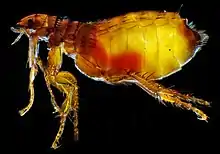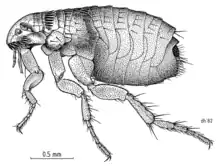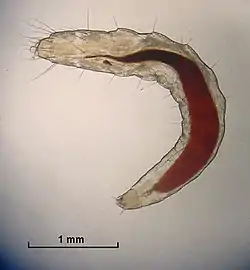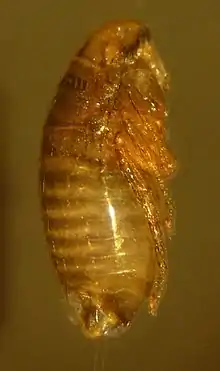Cat flea
The cat flea (scientific name Ctenocephalides felis) is an extremely common parasitic insect whose principal host is the domestic cat, although a high proportion of the fleas found on dogs also belong to this species.[3] This is despite the widespread existence of a separate and well-established "dog" flea, Ctenocephalides canis.
| Cat flea | |
|---|---|
 | |
| Female cat flea | |
| Scientific classification | |
| Kingdom: | Animalia |
| Phylum: | Arthropoda |
| Class: | Insecta |
| Order: | Siphonaptera |
| Family: | Pulicidae |
| Genus: | Ctenocephalides |
| Species: | C. felis |
| Binomial name | |
| Ctenocephalides felis (Bouché, 1835) | |
| Subspecies[2] | |
| |
| Synonyms | |
|
Pulex felis Bouché, 1835 | |
Overview

The cat flea belongs to the insect order Siphonaptera which in its adult stage is an obligatory hematophage. Adults of both sexes range from 1–2 mm long and are usually a reddish-brown colour, although the abdomens of gravid females often swell with eggs causing them to appear banded in cream and dark brown. Like all fleas, the cat flea is compressed laterally allowing it to slip between the sometimes dense hairs of its host just above the top layer of the skin, resulting in an extremely thin insect that may be difficult to observe even if the host's coat is pure white.[4]
The cat flea affects both the cat and the dog worldwide.[5] The cat flea can also maintain its life cycle on other carnivores and on omnivores, but these are only chosen when more acceptable hosts become unavailable.[4] Adult cat fleas do not willingly leave their hosts, and inter-animal transfer of adult fleas is rare except in animals that share sleeping quarters. A flea which becomes separated from its host will often die within hours from starvation.[6]
Life cycle
Fleas go through four life cycle stages of egg, larva, pupa, and imago (adult). Adult fleas must feed on blood before they can become capable of reproduction.[7]
Flea populations are distributed with about 50% eggs, 35% larvae, 10% pupae, and 5% adults.[8]
Eggs

An adult gravid female flea that has consumed a full blood meal will begin to produce between 20 and 30 microscopic (0.5 mm) non-adhesive white ovoid eggs per day, laying them individually and continually at a rate of about one per hour until she dies (under ideal conditions it might be possible for her to produce between 2,000 and 8,000 eggs in her lifetime, though most only manage to produce around 100 before being consumed by their host during grooming activity[6]). The eggs are dispersed freely into the environment. Within two to seven weeks a certain proportion will then hatch into larvae.[3]
Larvae

The larva of the cat flea has a grub-like appearance and is ~2 mm in length. The larvae are negatively phototaxic/phototropic, avoiding light and hiding in the substrate around them. The larvae require adequate ambient moisture and warmth, and will die at temperatures near freezing.[6] While in this developmental stage the larvae will feed on a variety of organic substances, but the most important dietary item for them is the crumbs of dried blood that continually fall like snow out of the haircoat of the host after it has been excreted by the adult fleas as fecal material. Thus, the adult flea population continually feeds the larval population in the animal's environment.
Pupal stage

Flea larvae metamorphose through four stages before spinning a cocoon and entering the pupal stage. The cocoon is adhesive, and quickly acquires a coat of camouflage from surrounding dirt and dust. Pupation depends heavily on temperature and moisture, and takes a week or more to complete, though a fully pupated adult can remain inside of its cocoon in a state of semi-dormancy (called the "pupal window") awaiting signs of the presence of a host.[6][9][10][11]
Effects on the hosts
A few fleas on adult dogs or cats cause little harm unless the host becomes allergic to substances in the flea's saliva. The disease that results is called flea allergy dermatitis. Small animals with large infestations can lose enough bodily fluid to fleas feeding that dehydration may result. Cat fleas also may be responsible for disease transmission through humans, and have been suspected as transmission agents of plague. Severe flea infestations can result in anemia due to blood loss.
Disease transmission
Cat fleas can transmit other parasites and infections to dogs and cats and also to humans. The most prominent of these are Bartonella, murine typhus, and apedermatitis. The tapeworm Dipylidium caninum can be transmitted when an immature flea is swallowed by pets or humans. In addition, cat fleas have been found to carry Borrelia burgdorferi, the etiologic agent of Lyme disease, but their ability to transmit the disease is unclear.[12]
Treatment
Since more than three-quarters of a flea's life is spent somewhere other than on the host animal, it is not adequate to treat only the host; it is important also to treat the host's environment. Thorough vacuuming, washing linens in hot water, and treating all hosts in the immediate environment (the entire household, for example) is essential for successful eradication. These steps should be performed on a regular basis.[13]
See also
- Pulicosis (Flea bites)
References
- European wildcat species account Archived 2013-03-08 at the Wayback Machine IUCN Species Survival Commission. Cat Specialist Group
- "Ctenocephalides". NCBI taxonomy. Bethesda, MD: National Center for Biotechnology Information. Retrieved 16 January 2019.
- Sue Paterson (16 March 2009). Manual of Skin Diseases of the Dog and Cat. John Wiley & Sons. p. 122. ISBN 978-1-4443-0932-4.
- "Cat flea". Connecticut Agricultural Experiment Station. Retrieved 2008-10-17.
- Rust, MK; Dryden, MW (1997). "The biology, ecology, and management of the cat flea". Annual Review of Entomology. 42: 451–73. doi:10.1146/annurev.ento.42.1.451. PMID 9017899.
- Dennis Jacobs; Mark Fox; Lynda Gibbons; Carlos Hermosilla (5 October 2015). Principles of Veterinary Parasitology. Wiley. p. 34. ISBN 978-1-118-97744-6.
- Fleas. P.G. Koehler and F. M. Oi. Printed July 1993, revised February 2003. Provided by the University of Florida
- Crosby, J.T. What is the Life Cycle of the Flea. Accessed 6 August 2012
- "Fleas". University of Florida. Retrieved 2009-03-13.
- "Insects and Ticks: Fleas". Entomology Department at Purdue University. Retrieved 2008-09-08.
- "The Biology, Ecology and Management of the Cat Flea" (PDF). University of California, Riverside. Archived from the original (PDF) on 2007-01-05. Retrieved 2008-09-08.
- Teltow GJ, Fournier PV, Rawlings JA (May 1991). "Isolation of Borrelia burgdorferi from arthropods collected in Texas". Am J Trop Med Hyg. 44 (5): 469–74. PMID 2063950.
- "Discover Entomology at Texas A&M University - Extension Publication E-433: Controlling Fleas". Archived from the original on 2014-12-26.
External links
| Wikimedia Commons has media related to Ctenocephalides felis. |
